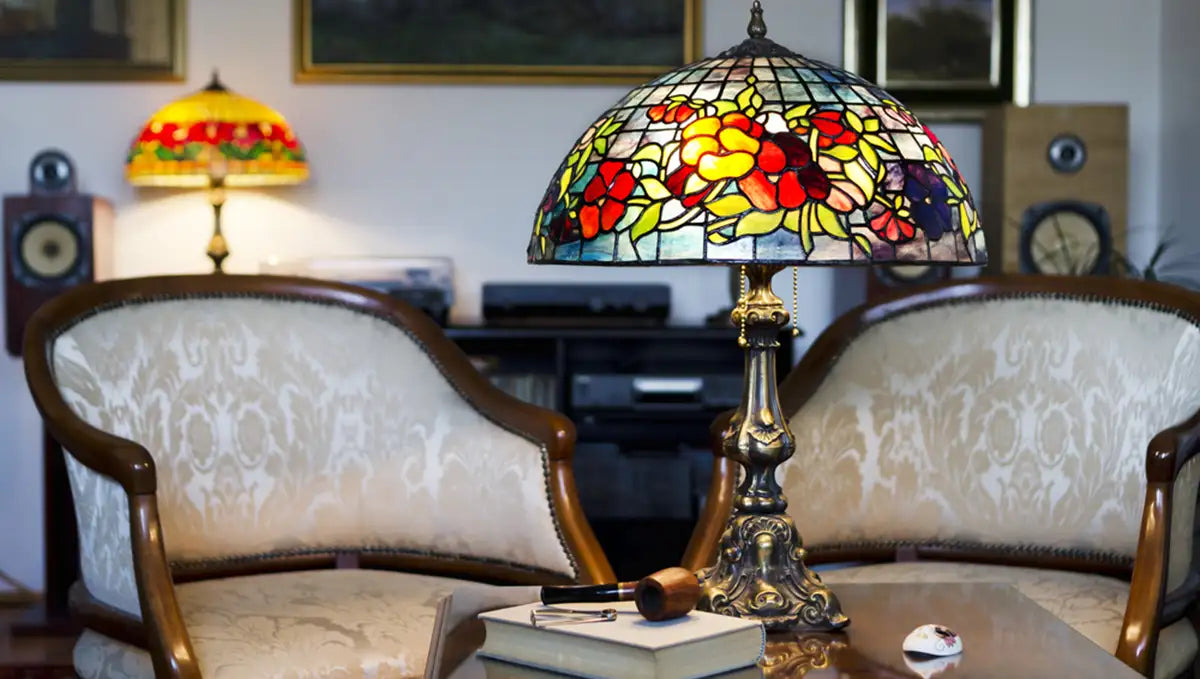Have you ever wondered what makes a Tiffany lamp so special?
I'm here to shed some light on these stunning pieces of art.
Let's dive into the world of Tiffany lamps and discover why they're more than just pretty lights.
The Radiant History of Tiffany Lamps

A Tiffany lamp is a type of decorative lamp characterized by its stained glass shade, designed by Louis Comfort Tiffany and his artisans.
Tiffany lamps first dazzled the world in 1893. They quickly became the talk of the town after their debut at the World's Columbian Exposition in Chicago.
But who was behind these luminous creations? While Louis Comfort Tiffany often gets the credit, it's time to shine a light on the unsung heroes.
The Tiffany Girls: The True Artisans
Did you know that many Tiffany lamp designs were actually created by Clara Driscoll and her team of female artisans? These talented women, known as the "Tiffany Girls," were the real masterminds behind many iconic designs.
What Makes a Tiffany Lamp Unique?

So, what exactly is a Tiffany lamp? Let's break it down:
- Stained glass shades
- Nature-inspired designs
- Handcrafted using the copper-foil technique
- Vibrant colors and textures
The Anatomy of a Tiffany Lamp

| Part | Description |
|---|---|
| Shade | Stained glass in various colors and patterns |
| Base | Often bronze, can be decorative or simple |
| Light Source | Originally oil, now electric |
| Copper Foil | Holds glass pieces together |
The Art of Copper Foil
Tiffany lamps use a special technique called copper foil. This method allows for more intricate designs than traditional leaded glass.
Here's a simple breakdown of the process:
- Cut glass pieces to shape
- Wrap edges with copper foil
- Solder pieces together
- Create stunning, delicate patterns
The Art of Creating a Tiffany Lamp
Ever wondered how these beauties are made? It's a process that requires patience, skill, and an eye for detail.
- Design: The pattern is drawn and a mold is created.
- Glass Selection: Artisans choose from a rainbow of colors and textures.
- Cutting: Each piece of glass is carefully cut to fit the design.
- Assembly: Using the copper foil technique, pieces are joined together.
- Soldering: The lamp is soldered for strength and durability.
- Finishing Touches: The base is attached, and voila! A Tiffany lamp is born.
Popular Tiffany Lamp Styles

Tiffany lamps come in various styles. Here are some fan favorites:
| Style | Description |
|---|---|
| Dragonfly | Features delicate dragonfly designs |
| Wisteria | Cascading purple flowers |
| Geometric | Bold shapes and patterns |
| Peacock | Vibrant feather-inspired designs |
Which style catches your eye?
The Tiffany Lamp Legacy
Tiffany lamps aren't just pretty faces. They're a significant part of art history.
Art Nouveau Movement
These lamps are shining examples of the Art Nouveau movement. They embody the era's love for natural forms and flowing lines.
Collectible Treasures
Today, original Tiffany lamps are highly sought after by collectors. Some have even sold for millions at auctions!
Caring for Your Tiffany Lamp
If you're lucky enough to own a Tiffany lamp, here are some tips to keep it glowing:
- Dust gently with a soft brush
- Avoid harsh cleaners
- Keep away from direct sunlight
- Handle with care - they're delicate!
Modern Tiffany-Style Lamps
Can't afford an original? Don't worry! Many companies now create beautiful Tiffany-style lamps.
These modern interpretations capture the essence of Tiffany's designs at a fraction of the cost.
Final Thoughts: The Timeless Appeal of Tiffany Lamps
So, what is a Tiffany lamp? It's more than just a light source. It's a piece of history, a work of art, and a testament to incredible craftsmanship.
From their humble beginnings to their status as coveted collectibles, Tiffany lamps continue to captivate us with their beauty and charm.
Featured Articles
How to Identify a Tiffany Lamp? Discover Expert Tips Now!
Why Are Tiffany Lamps So Valuable? Uncover the Hidden Secret










Leave a comment
All comments are moderated before being published.
This site is protected by hCaptcha and the hCaptcha Privacy Policy and Terms of Service apply.